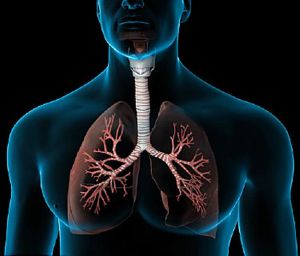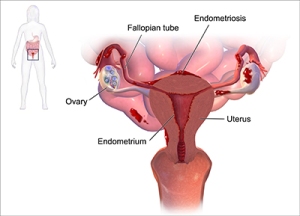 The complaint is often one of almost incapacitating pain in the pelvis and lower back which is at its worse during ovulation, menstruation or sexual intercourse. This is made possible by uterine tissue attaching itself to other organs, e.g. the fallopian tubes, ovaries, on the outside of the uterus, bladder, and even the lungs where it continues to function as if it were still in the womb. Hence they fill up with blood every month, but unlike menstrual blood which is released by the vagina, this blood remains in the tissue spaces and form cysts which can in turn grow large enough to bind organs together.
The complaint is often one of almost incapacitating pain in the pelvis and lower back which is at its worse during ovulation, menstruation or sexual intercourse. This is made possible by uterine tissue attaching itself to other organs, e.g. the fallopian tubes, ovaries, on the outside of the uterus, bladder, and even the lungs where it continues to function as if it were still in the womb. Hence they fill up with blood every month, but unlike menstrual blood which is released by the vagina, this blood remains in the tissue spaces and form cysts which can in turn grow large enough to bind organs together.
 One of the theories how uterine tissue is able to find itself in other areas of the body is that endometrial cells travel to the pelvic cavity through the bloodstream or the lymphatic system. Another is that it is caused when the body is still an embryo because endometrial cells of some foetuses don’t differentiate themselves and make the trip to the appropriate sites, thus ending up in the wrong places. Environmental oestrogens, and endocrine disruptors, also receive some of the blame. They take the forms of plastics, detergents, pesticides, household cleaners, etc.
One of the theories how uterine tissue is able to find itself in other areas of the body is that endometrial cells travel to the pelvic cavity through the bloodstream or the lymphatic system. Another is that it is caused when the body is still an embryo because endometrial cells of some foetuses don’t differentiate themselves and make the trip to the appropriate sites, thus ending up in the wrong places. Environmental oestrogens, and endocrine disruptors, also receive some of the blame. They take the forms of plastics, detergents, pesticides, household cleaners, etc.
 The bottom line is that all cases of endometriosis are connected to hormonal imbalance with elevated oestrogen levels being a problem. The liver is responsible for metabolizing oestrogen and secreting the residue into the large intestine for elimination, but if this does not happen properly the metabolites get recycled throughout the body. This gives some indication that it is not a simple condition to treat and therefore requires a multi-pronged approach that includes regulating hormones and balancing the immune system.
The bottom line is that all cases of endometriosis are connected to hormonal imbalance with elevated oestrogen levels being a problem. The liver is responsible for metabolizing oestrogen and secreting the residue into the large intestine for elimination, but if this does not happen properly the metabolites get recycled throughout the body. This gives some indication that it is not a simple condition to treat and therefore requires a multi-pronged approach that includes regulating hormones and balancing the immune system.
At A Glance
Causes: included are imbalanced immune system, flora imbalance (dysbiosis), high levels of oestrogen and low progesterone, poor liver function, hereditary, retrograde menstruation, and endometrial cells that travels through the blood stream.
Treatment: a high fibre diet will help to balance the friendly bacteria that metabolize oestrogen. Drink plenty of water and eat fruits and vegetables. Supplement the diet with Red raspberry tea which helps with uterine inflammation and pain.
Prevention: the client should avoid red meats, processed foods, refined sugar, caffeine, and alcohol.